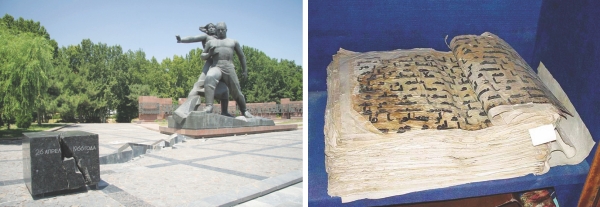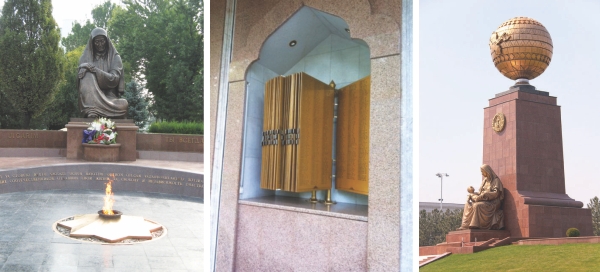| Home - Back Issues - The Team - Contact Us |
 |
| Volume 11 |Issue 36| September 14, 2012 | |
|
|
A Roman Column
A Central Asian Journey Neeman Sobhan At the mention of Tashkent, a certain generation of sub-continentals immediately date themselves by saying: “Wasn't that where Lal Bahadur Shastri died after the 1965 Indo-Pakistan war?” I was a schoolgirl then, but this was my reaction, too, at the start of our Uzbekistan trip. So, Tashkent to me is a falsely familiar place from childhood shrouded in the grainy grey of news reels with a tiny and frail Indian Prime Minister standing waist high to the tall and florid Pakistani President, Ayub Khan, and the Russian premier Kosygin, all assembled in this former USSR city for peace talks in a long-ago January in 1966. Fast forward to the present. As our plane from Bishkek lands at Tashkent or Toshkent airport, I find a gleaming new city. Its name means 'the city of stone' but I find a city of steel and glass, which in 1999 replaced its Soviet style façade to become this flashy, cosmopolitan capital. We are met by two smart young girls from the tourism agency. One is of Russian origin and pretty, in a tall and European way; the other is of ethnic Uzbek origin and also pretty, but in a petite and slant-eyed way. The Russian speaks English and talks proudly of her city, with 'the largest', 'the tallest', 'the best' peppering her speech as the city unfolds before us through the car windows. A landscaped metropolis of sparkling skyscrapers, shopping malls, and restaurants. Wide boulevards with shady trees and leafy parks abound, but unlike Bishkek everything here is larger, more elegant, and the billboards and signs on the roads are in both English and Russian. By the time we reach our sleek hotel, the Dedeman Silk Road on Amir Temur street in the centre, we can see that Uzbekistan is a rich, prosperous country, and Tashkent a worthy capital.
It is late afternoon and we have barely enough time to see the sights because early the next morning we are to take the train to Samarkand. Tashkent for us was only a transition point but between this arrival day and the last day on our return trip from Bokhara, when we spend a day and night in Tashkent again before flying to Istanbul, the following are the main sights of Tashkent we visited. The Independence or Mustakillik Square: This is the largest and the main square of the country, and like a sprawling park with many monuments and fountains, surrounded by imposing administrative offices of the Cabinet and the Senate. The entrance to the square is framed by an arch topped by the sculptural images of storks.
In the centre of the square on the granite pedestal is the symbol of independence, a mammoth Bronze globe with an image of the Republic of Uzbekistan on it. At the foot of the obelisk is the Statue of the Happy Mother with a baby in her arms. The Memory Square complex to honour Uzbek soldiers who died in the Second World War. In an ironic contrast to the Happy Mother statue mentioned above, to the north side of the Independence square, and at the end of what is called the Alley of Memory sits the Statue of the Grieving Mother before the eternal flame: a mother waiting for the son who never returned. Located on both sides of this alley are the open galleries with carved pillars and 14 niches (the number of country's regions) bearing the Bronze Memory Books: metal pages carved with the names of all Uzbeks who sacrificed their lives. The Monument to Courage: This is built on the epicentre of the 9-point earthquake that destroyed the city in April 26,1966. It is dedicated to the courageous spirit of the citizens who rebuilt their city and their lives from scratch. The monument consists of a stone cube split in two, one side showing the time the earthquake happened, while the other side, the date of the incident. A crack in the earth extends from the cube to the sculpture which depicts a woman and a child with a man in front shielding them from harm. On the sides are relief compositions describing the restoration of Tashkent. Tashkent TV tower: At 375 metres, this is the tallest tower in Central Asia, and ranks 11th among the tallest towers of the world. There is a revolving restaurant at 110 metres with a panoramic view of Tashkent. Khast Imam Mosque in the old city has a rich library of oriental manuscripts, among them the famous Quran of Caliph Uthman, handwritten by him and considered to be the oldest extant Qur'an in the world. Dating from 655, consisting of 353 parchment sheets of very large script and stained with the blood of the murdered Caliph, it was brought by Temur to Samarkand, then taken by the Russians to St. Petersburg. It was returned to Uzbekistan in 1924, where Russian scientists proved its authenticity. Amir Temur Park and Square: An equestrian statue of Temur (Tamerlane) stands in the square named after him, from which radiates the main streets of this ancient new city, once an important stop on the famous Silk Road.
|
||||||||||||||
Copyright
(R) thedailystar.net 2012 |
|||||||||||||||


